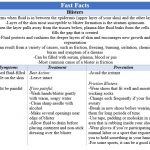Why do they hurt so bad?
You wore a new pair of shoes to work today. Gradually, throughout the day your left heel has been bothering you and by the time you get home, it’s really hurting. You take off your shoes and notice that you have a blister in the area where the pain is. What can you do to make it better? Are there ways to prevent it from happening again?
 Definition
Definition
A blister is formed when fluid is in between the epidermis (upper layer of your skin) and the other layers. The layer of the skin most susceptible to blister formation is the stratum spinosum. When this layer pulls away from the tissues below, plasma-like fluid leaks from the cells and fills the gap that is created. This fluid does a couple of things. It protects and cushions the deeper layers of skin and encourages new growth and regeneration. The rate at which the body heals itself is amazing. Just 6 hours after the blister appears, cells at the base start to take up amino acids and nucleotides, which are the building blocks of protein and DNA. By the 24-hour mark, cell division has increased significantly and new skin layers above the stratum spinosum are steadily forming. Two days later, a new layer of skin can be seen. Five days after the injury, a new upper layer of skin is evident. While the new cells are developing, the fluid is reabsorbed and the swelling subsides. The more painful blisters typically appear on the palm of the hands or soles of the feet because they’re the result of tissue shearing in deeper layers of the skin, which are closer to nerve endings.
Blisters can result from a variety of causes, such as friction, freezing, burning, irritation, chemical burns and symptom of a disease. They can be filled with serum, plasma, blood or pus. The most common cause of a blister is friction on the skin from repetitive action. This type usually appears on the hands or feet and are more likely to form if the conditions are warm and damp, like inside a shoe. Another common cause of blisters is temperature extremes. When something is too hot, it burns the skin and a blister results as a way for the skin to protect the deeper layers. A quick way to tell the difference between first- and second-degree burns is how soon they blister. Second-degree will blister immediately, but first-degree don’t blister until a few days later. When your skin is really cold, like when you have frostbite, the same defense mechanism is triggered, resulting in a blister. If your skin is exposed to certain chemicals, it can blister (this is also known as contact dermatitis). Some chemicals that can cause this reaction are cosmetics, detergents, solvents, nickel sulfate (used in electroplating), balsam of Peru (a flavoring), insect bites/stings and chemical warfare agents (ex. mustard gas). Sometimes, a small blood vessel near the surface of your skin is ruptured, which causes blood to leak into the space between the layers of skin. This is known as a blood blister. A substantial amount of diseases can cause blisters. Some of these are chickenpox, herpes, bullous impetigo, eczema, dyshidrosis, bullous pemphigoid, pemphigus, dermatitis herpetiformis, cutaneous radiation syndrome and epidermolysis bullosa.
Treatment
The good news is that most blisters don’t require being seen by a doctor. The best treatment for a blister is to leave it intact because it protects against bacteria and infection. However, a blister can be too painful to do this. So, the best thing to do is to drain the fluid but leave the skin covering the area. In order to minimize the risk of infection, you should wash your hands and the blister gently with warm, soapy water. Next, you should clean a sharp needle with rubbing alcohol. Once everything is cleaned, use the needle to create several small openings near the edge of the blister. This should allow the fluid to come out, but leave the skin in one piece. After you drain as much of the fluid as possible, put ointment on the blister and cover it with a non-stick dressing. Over the next several days, keep the area clean and monitor it for any signs of infection. Once the area heals, the damaged skin will dry and peel off.
Prevention
In order to prevent blisters, avoid things that cause them. Since friction blisters are the most common, let’s take a look at the best way to avoid them. When it comes to protecting your feet, it’s important to wear shoes that fit well and moisture-wicking socks. If your feet are prone to getting sweaty, it can be helpful to change your sock frequently. If you have new shoes, it’s a good idea to break them in before wearing them for long periods of time, this is especially true for walking or hiking boots. If there’s a spot that is rubbing inside your shoe, use tape, padding or moleskin in the area. There are things that you can do to protect your hands from getting blisters. The most important is to wear gloves if you’re participating in manual labor or a sport that requires you to hold something in your hands. For some sports, it can be a good idea to tape up your hands to reduce the chances of blister forming.
There’s no question that blisters are annoying and painful. However, there are things you can do to avoid them. If you have any questions or concerns about blisters, please speak with your doctor. If you would like more information, please visit the American Academy of Dermatology’s blisters page at https://www.aad.org/public/everyday-care/injured-skin/burns/prevent-treat-blisters